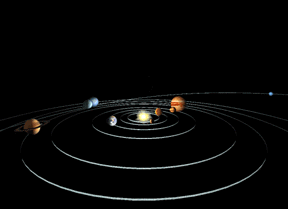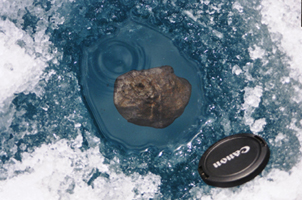The Tagish Meteorite was probably about 5 meters across before it entered the Earth's atmosphere. It broke apart before landing on the icy lake. Before the rising temperatures of spring melted the ice on the lake, over 500 meteorite fragments were found, 410 fragments were documented and about 200 fragments were recovered. One of the meteorite fragments appears here in the ice of Tagish Lake. The camera lense cap was placed next to the meteorite fragment for size comparison purposes.
Click on image for full size
Image courtesy of the University of Western Ontario and the University of Calgary
A Look at the Solar System's Past - the Tagish Meteorite
News story originally written on September 24, 2001
Have you ever looked at pictures of friends or relatives to see what they looked like when they were very young? That is what some scientists are trying to do with a meteorite that fell in Canada. This meteorite helps scientists understand what
the solar system was like as it was forming.
The meteorite, named the Tagish Lake Meteorite, is made up of the same dust and gases that the solar system was formed from. Because it is made from the same material, scientists can study the meteorite and see what our very young solar system was like.
The reason this meteorite is special is that it contains only simple molecules. This means that it was formed very early in the birth of our solar system, and so gives scientists a picture of what the solar system was like at an earlier point than all the other meteorites that have ever been found. In a way, the Tagish Lake Meteorite is like a picture of the solar system, and in this case, a baby picture!
You might also be interested in:

Scientists believe that the solar system was formed when a cloud of gas and dust in space was disturbed, maybe by the expl osion of a nearby star (called a supernova). This explosion made waves in space
...more
It was another exciting and frustrating year for the space science program. It seemed that every step forward led to one backwards. Either way, NASA led the way to a great century of discovery. Unfortunately,
...more
The Space Shuttle Discovery lifted off from Kennedy Space Center on October 29th at 2:19 p.m. EST. The sky was clear and the weather was great. This was the America's 123rd manned space mission. A huge
...more
Scientists found a satellite orbiting the asteroid, Eugenia. This is the second one ever! A special telescope allows scientists to look through Earth's atmosphere. The first satellite found was Dactyl.
...more
The United States wants Russia to put the service module in orbit! The module is part of the International Space Station. It was supposed to be in space over 2 years ago. Russia just sent supplies to the
...more
A coronal mass ejection (CME) happened on the Sun last month. The material that was thrown out from this explosion passed the ACE spacecraft. ACE measured some exciting things as the CME material passed
...more
Trees and plants are a very important part of this Earth. Trees and plants are nature's air conditioning because they help keep our Earth cool. On a summer day, walking bare-foot on the sidewalk burns,
...more















